Siding block house: characteristics and scope
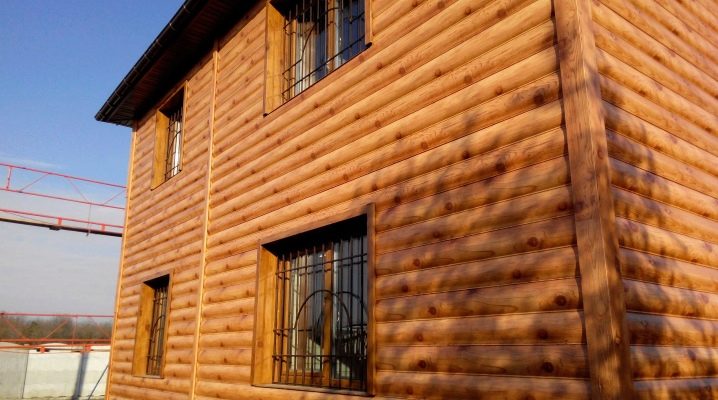
Block-house siding has specific characteristics, but it has gained popularity both among professional builders and among those who design their private home on their own. First, you need to figure out what a "block house" is, what is the scope of its application, how to use it correctly, including when decorating the interior.



What it is?
Many English language learners immediately had an involuntary association with the block structure when they heard the Russified version of the expression "block house". Indeed, in Western countries, this expression denotes a structure that is quickly erected from blocks, but, like a traditional house, is habitable. In Russia, things are a little different. In our country, the newfangled expression "block house" denotes a facing material that is most often used for the exterior decoration of a building, although there are also many options for using "block house" panels for organizing the interior.

Due to the peculiarities of production and fastening, the "block house" material is often compared with eurolining. By and large, the "block house" is the same lining, but made of different parts of the logs. If the lining is able to guarantee a beautiful even surface, then the "block house" helps in creating a cladding that is as similar as possible to real logs. Therefore, it is more often used outdoors, and not indoors, because from the outside such sheathing looks much more spectacular than inside.






"Block house" can be made from various materials, including wood, metal and even plastic. Each of these options has its own characteristics, and where one can be used, problems arise with the other.
For example, seemingly universal vinyl can be mounted anywhere, but in hot climates where the temperature reaches 40 degrees, it is not recommended to use a vinyl "block house" - it is much better to choose a wooden version.
"Block House" is suitable for decorating various wall coverings: concrete, brick, wood, block and many others. Largely due to its versatility, the material gained such wild popularity, first among a narrow circle of specialists, and then among the population. In addition to being workable on virtually any starting surface, the panels are easy to attach. You don't need any special knowledge or skills: you just need to follow a few simple rules in order to set up the "block house" correctly.


Speaking about the purposes of using these imitating timber panels, one cannot fail to mention their functional side. In addition to the fact that the "block house" just looks beautiful, it also allows you to cover up all the shortcomings of the original walls.
For example, situations often arise when an inexperienced master made some mistakes when erecting a brick wall, and now the bricks are uneven, as they say, at random. Just for such cases, the "block house" is suitable: it will cover all the irregularities, but the aesthetics of the structure will remain, although not in the form in which it was conceived.
Another function that is performed by the "block house" is insulation. Sometimes the walls are sheathed with these slabs, not only in order to make the home more attractive, but also in order to further isolate the walls from moisture and drafts. In such cases, you need to act carefully, since the "block house" requires delicacy in handling. As a rule, block-house panels are used as insulation only by experienced craftsmen who know all the nuances of preparation and processing of substrates.
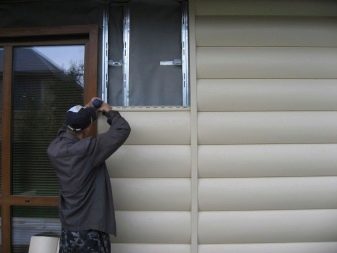

Advantages and disadvantages
Block house siding is the same building material as the rest, so it is logical that it has both advantages and disadvantages.
Fortunately for many, the benefits of panels are somewhat greater.
- If we consider the wooden version, then we can say with confidence that only high-quality wood is used in the production. As a rule, conifers are selected. This is due to several factors at once. First, the more resinous conifers retain the temperature better. Secondly, they are durable. Thirdly, if you warm up the resinous wood well, it will harden, becoming almost stone. Thus, the maximum reliability of the coating is achieved.
- It is impossible not to mention the aesthetic appeal of such a finish. The high-quality imitation of wood, created with the help of "block house" -panels, is sometimes indistinguishable from real log masonry. This property of the material is used by many designers, given that it is much cheaper to purchase such material than to immediately build a real log hut.


- The material is versatile, since it can be used for both exterior and interior decoration. Outside, wide lamellas are used, while narrow patterns are chosen for interior decoration. By the way, if you decorate the walls with a "block house" inside, then you can get another pleasant addition in the form of a pleasant coniferous smell, which does not fade over the years thanks to the resin contained in wooden blanks.
- The panels are often sheathed in wooden houses that are in an unsightly condition. This is due to the fact that it is not possible to return the logs to their former appearance, while finishing with a "block house" is a good opportunity to recreate the former chic of a log structure, while significantly saving on its restoration. To prevent the panels from cracking, special grooves are made on their inner side, which prevent corrosive changes.

The material also has several drawbacks that cannot be ignored.
- The almost complete lack of ventilation between the sub-base and the "block house" panels causes great difficulties. This can lead to the formation of concentrate on the inside, which in turn can cause rot, mildew or mildew on the main walls if not properly treated. There are two solutions to this problem: the first is to create special ventilation holes, and the second is to warm up the walls well so that the condensate dries out on warm surfaces. Although the second option is more aesthetically pleasing than the first, it is much more expensive, because you have to spend a lot on heating.
- The panels will have to be carefully looked after: they are easily scratched, warped, darkened. Every year they will need to be updated with varnish, and every five years, the entire coating will be overhauled. Some lamellas may need to be completely replaced. All this causes justified concern among many, since it will require not only labor investments (and considerable ones), but also financial ones.

The material has both positive and negative sides. Before dwelling on the choice of block house material, you need to weigh the pros and cons. You may not be able to maintain the coating on a regular basis. Then it makes no sense to mount such panels, since without proper care they will retain their original attractive appearance for a very short time.


Features of production
After the progenitor of the "block house" clapboard became popular, it also became popular. This happened in the late 90s of the XX century - quite recently by the standards of the construction market. Nevertheless, the "block house" quickly gained popularity, since it made it possible to make production virtually waste-free.
The technology by which the "block house" is produced is called "a square in a circle". This means that a square interior is cut from the dry profiled log. In the future, she goes to a bar or board. The remaining side parts (flat on one side and convex on the other) are used to make a "block house". It is extremely rare that a block-house lining is made like a regular lining by processing edged boards on a special device - a milling machine.

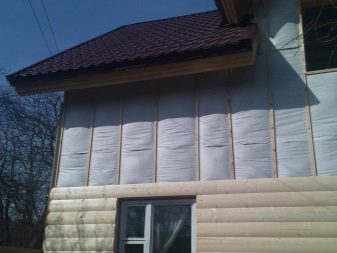
As mentioned above, most often block-house lumber is made from conifers, but this is not the end of it.
For these purposes, other types of wood are also used.
- Pine. This is the variety of needles that is chosen more often than others due to its low cost and excellent quality characteristics. From pine, a light "block house" is obtained, which cannot be called any outstanding, from an aesthetic point of view, but it is quite pleasant to look at. Pine lamellas have a pronounced pattern, which is usually emphasized with varnish.
- Larch. This material is one of the favorites due to the beautiful color and pattern of the wood. The wood has a noble appearance, looks expensive and soundly. In addition, larch has extremely high strength characteristics. It costs a little more than pine, however, judging by the reviews, this difference is not so significant if we take into account the general difference between the species.

- Cedar. This tree produces a fragrant "block house" with high aesthetic and technical characteristics. However, it is worth remembering that cedar is a soft tree, so you should not expect the same strength from it as from pine or oak. The positive property of the cedar "block house" is that due to the special antiseptic properties of wood, the lamellas are practically not subject to decay.
- Linden. Linden "block-house" is categorically not suitable for external work, but inside the room, wood has no equal. Since linden belongs to soft trees, it is very easy to work with it: it bends well, does not break. Linden boards are not affected by rodents, so there is no need to fear for the appearance of such walls. An excellent solution would be to polish them or paint them: both of them will look good on a fake "block house".


- Alder. Alder can be classified as a versatile building material. Due to the fact that in the air it changes color (immediately after the felling it is white, but darkens over time), it turns out to stylize alder like valuable tree species, for example, a walnut. It is quite problematic to meet a "block house" made of alder, since it is more often used for making a floorboard, but some still choose this material as a finishing material for the walls.
- Spruce. Spruce cannot be called a dense material: it is only slightly denser than cedar. However, a "block house" is made from it no less often than from pine, which is due to the cheapness of the material: there is as much spruce lumber as pine. Spruce "block house" surpasses pine in flexibility, which is often taken into account. Spruce has a low resin content, so in climates with not very hot summers and cold winters, this "block house" would be an ideal choice.
- Oak. The most expensive of all. Oak surpasses all others in strength and aesthetic properties. The most beautiful are Canadian oak, which has a pleasant soft color and a pronounced pattern, and stained, which is characterized by dark saturated shades with silvery veins.As a rule, a "block house" made of such materials is rather an exception to the rule, since those who can afford such material can build a whole house out of it.



Varieties and characteristics
Above was considered in detail the wooden "block house", which is the most popular. However, the entire list of available options is not limited to this. So, there are also artificial vinyl panels, with the help of which they skillfully achieve the appearance of a wooden surface, and metal ones, usually made of galvanized steel.
Vinyl block house is a great alternative to the classic wood house if you are financially constrained. It has several advantages.
- Unlike wood, it does not rot and is non-combustible. For example, if a house catches fire, then a block house made of wood will only support the combustion, while a vinyl analogue will only smolder.
- The vinyl equivalent is more resistant to mechanical stress, since vinyl is not as easy to scratch as wood. From this it is logical to conclude that vinyl panels will retain their pleasant appearance longer.


- The temperature range is much wider. Vinyl can withstand drops from -50 to +60 degrees without losing its technological characteristics.
- Reproduces sample material perfectly. If solid wood is taken as the basis, then from afar it is impossible to distinguish vinyl imitation from real wood. Both color and pattern can be easily recreated using dyeing and embossing. If you wish, you can even make an imitation of the aged surface if you use a brushed "block house".
- Vinyl will not fade. If, under the influence of constant ultraviolet radiation, the tree gradually dries up and loses its former color saturation, then this will not happen with vinyl: it is resistant to this.

- Vinyl panels are much easier to mount: they are presented as a ready-made canvas, which you just need to place in the correct way and secure. In the case of wooden lamellas, the situation is different: you need to lay each of the blocks of the "block house" one after the other.
- It is much easier to maintain vinyl panels than wooden ones. Here, care consists only in periodic cleansing and maintaining an attractive appearance. There is no need to varnish or polish the "block house" panels from time to time.

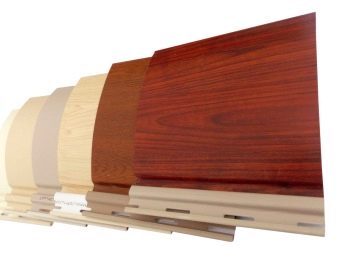
As you can see, the characteristics of the "block house" made of vinyl surpass those of the analogue made of wood, but wood has one advantage that cannot be overridden by anything - it is a natural look. In the end, if you have financial problems, you can choose not a classic high-quality "block house", but options from slabs or glued logs, which are not much inferior to traditional samples.
Do not forget that there is also a metal "block house", which also differs in a number of specific characteristics.
- The youngest of all "block house" options. The metal version, painted "wood-like", appeared quite recently, but many immediately appreciated the convenience and functionality. Despite their recent appearance, metal variants are popular.
- Metal "block house" panels are made of galvanized steel, treated and coated with various other substances, including a primer, chrome plating, polyester for insulation, and so on. It is logical to conclude that this option is not used for the inner compartment, remaining mainly as a facing material.
- The temperature variation that metal can withstand is even greater than that of vinyl. Here it ranges from -50 to +80 degrees.
- The "block house" made of metal has an increased warranty. Manufacturers claim that it can last up to 50 years.


- Like vinyl panels, metal panels do not burn. However, they become very hot when exposed to high temperatures, and such an intense heat can lead to further ignition of the base if it is made of wood.
- The metal not only resists ultraviolet light well, but also protects the walls of the home from aggressive environmental influences. Various chemicals are not afraid of galvanized steel: alkalis, acids, all kinds of toxic solvents. However, you still need to be careful, since these substances can easily remove the decorative layer.
- Unlike vinyl flooring, a block house made of metal does not prevent the walls from breathing, so there is no greenhouse effect in the space between the decorative panel and the base.

- Since during the installation of metal panels, it is necessary to additionally insulate the walls, in the future you can significantly save on heating the building.
- Metal, like wood, is environmentally friendly.
- Due to the small thickness of the panels, there are no problems with joining. The joints are almost invisible, and there is a feeling of the integrity of the entire coating.
- Installation of a metal "block house" is very simple, so it can be done even by a beginner.
- The price for metal panels is quite affordable.


Before choosing one or another option, you need to carefully read all the characteristics and specific features and only after that make the final choice.
Returning to the theme of wood, it is worth noting that "block house" panels are produced in several categories: A, B, C or AB. They vary greatly in the quality of the raw materials used.
- Class A wood refers to raw materials of the extra level. Only high quality samples are used here. They must have a perfectly smooth surface, flaws are unacceptable. You can find only subtle flaws.
- Class B wood may have small errors. The presence of several knots or wormholes for each running meter is acceptable, but they should not be too noticeable either: the class does not allow.


- Class C wood belongs to the lowest grade. There may be rough knots, wormholes, deep cracks. Such material, accordingly, is cheaper, since it loses in many respects to the previous two in aesthetic terms, but this does not mean at all that it is worse in an operational sense.
- To class AB includes the thickest panels. This category is intermediate. Knots and small cracks are acceptable here, but still not in the same amount as in the case of class B wood.


Dimensions (edit)
In total, three parameters are measured in relation to the "block house": width, thickness and length. Each of these values is clearly spelled out in the GOST standards, however, these requirements are not always met.
When choosing, you need to focus on typical indicators:
- 2x9x200 cm;
- 2x9x600 cm;
- 3x14x200 cm;
- 3x14x600 cm;
- 3.6x19x200 cm;
- 3.6x19x600 cm.


Accordingly, the first indicator is the thickness, the second is the width, and the third is the length. Despite the fact that a number of companies produce block-house siding of a different length, these standard sizes are the most popular in Russia.
Pay close attention to width and thickness. The purpose of the "house block" depends on these indicators: whether it was made for outdoor placement, suitable for a balcony, or only for installation inside a room.
- The narrow options (14 cm wide) are versatile. They will look good both in a large living room and as a decoration for the exterior of a building.
- The widest options are only suitable for outdoor applications. Indoors, they will take up a lot of free space due to their impressive thickness, and also visually make the room smaller.
- Narrow lamellas most of all resemble classic Euro lining, so they can be widely used in interior decoration of different rooms.

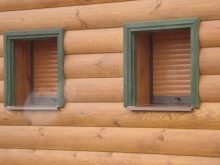

It is imperative to be guided by the size and thickness of the "block-house" -elements when choosing: they determine how harmoniously this type of Euro-lining will look in one place or another, whether it will fit into the surrounding space, how well it will perform its practical functions.
Colors
As it was clear from the previous sections, there is not only a "block house" of natural colors, but also dyed.
The question of painting mostly affects metal and vinyl panels, but it so happens that wood has to be painted as well.
- The most popular color for processing block-house elements is brown. This also applies to varnishing and conventional paint processing. This tendency is associated with the tradition of stylizing a "block house" from any material like wood, since it has a specific shape, and there are simply no other options. Brown can be of a wide variety of shades, ranging from coffee with milk to bog oak.
- Green is the universal color. You can often find fences painted in this shade, but not so long ago there was a tendency in design to give panels an olive or pistachio color. The result is a fairly natural, but at the same time not conspicuous coating.


- Another unusual solution is yellow. A light shade called "lemon" is great for enlivening the overall look, making the home unusual and interesting. If you add a pattern of veins to the "block house", you get the original texture of some exotic tree. It cannot be denied that this approach is not classic, but it has a right to exist, especially if you correctly combine the surrounding environment with this color of the house. An unusual solution here can be the coating of "block-house" -panels made of wood with golden lacquer. This will help achieve a beautiful pearlescent shine, but it is important not to overdo it with glitter.
- Along with pistachio, a rich emerald color is also interesting. Despite the seeming boldness, this shade does not look defiant. On the contrary, it is easy to combine it with the surrounding nature, especially if a spruce forest is laid out next to the house or some kind of coniferous composition is planted.
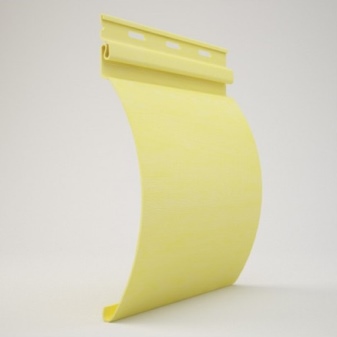

- The colors in red tones, stylized like mahogany, look interesting. Usually, alder is chosen for these purposes, but both metal and vinyl options are suitable. Such colors look expensive and soundly, but it is important to choose high-quality samples, otherwise there is a risk of spoiling the whole impression.
- Block house siding of unnaturally bright colors (yellow, peach, boiling white) does not look very good. There can be no question of any stylization, and the "block house" panels turn into what they really are - into a protective coating. In rare cases, rich options may look appropriate if all other finishing details are matched harmoniously: the door, the frames on the windows, the roof, and others.


When choosing one or another color, you should definitely think about whether it will start to annoy you after a while. If you know that you are a fickle person, then it is best to stop at the classic brown tones, choosing the warmth and intensity that are most pleasing to the eye.
A house covered with a "block house" will not be able to be repaired again in two months: this will entail significant financial and time costs, and will also lead to the fact that the money for the previous renovation will be wasted.


Scope of application
It makes no sense to dwell on the facade cladding, since this is already self-evident. It is worth noting that the "block house" material can be used to decorate premises for various purposes: it is suitable for both living rooms and utility rooms. No less popular is the use of "block house" panels for decorating country houses, gazebos or other buildings that are not intended for year-round living.




It becomes possible to harmonize the general appearance, giving the main house and the side building common features, to stylize them in a single direction.
- An interesting solution is to decorate a freestanding shower or toilet with block-house material. This will make the building more presentable if it is located outside. Indeed, "block house" -panels look much more attractive than ordinary cladding with boards with impressive gaps between them.It looks especially beautiful if the bathroom is relatively large, for example, 3x4 m. Then it, sheathed with a "block house", takes the form of a mini-house, and the site generally seems more comfortable and habitable.
- In addition to the balcony, the attic can be sheathed with "block house" panels. Here they will look very welcome, since the attic floor is usually not perceived as suitable for living - the "block house" is able to fix this. Firstly, it will make the attic room more comfortable. Secondly, insulation can be hidden under the panels, thereby making the room as warm as possible, without walking drafts. Thirdly, thanks to the special method of fastening, the "block house" will hold well both on an inclined wall and on the ceiling, if necessary.



- A frame house decorated with a "block house" made of any material will look more impressive and solid due to the additional volume. Many people prefer "block-house" instead of eurolining, because the second often does not give the house the desired look, making it light and, as it were, "paper-like" in appearance. The "block house" successfully imitates log masonry, and the frame structure turns into a hut or a chalet, depending on the chosen color of the material. Wooden material looks especially good here.
- When decorating the interior space (bedroom, living room, kitchen, corridor), the "block house" is also irreplaceable, especially when it is planned to maintain the facade and interior decoration in the same style. Beam-like walls are typical for rustic, chalet, and sometimes Provence styles, if any pastel and artificially aged material is chosen. When carrying out interior finishing work, it is necessary to give preference to wood panels: only they are sufficiently environmentally friendly. In addition, a pleasant coniferous smell will reign in such rooms, additionally disinfecting the air.



Installation features
The first and main feature is the location of the "block house" elements. As a rule, they are not placed vertically, since horizontal placement looks nice and harmonious. However, there are exceptions to every rule. The vertical arrangement is chosen when sheathing fences or any side buildings, for example, a barn. This arrangement can also be used when sheathing interior spaces, when you need to visually "raise" the ceiling. For example, this technique is used when trimming balconies or attics, since it will not look strange here.



When fastening outside the building, you will first need to create a frame of slats over the entire area of the walls. It is necessary so that there is something to attach the panels to. The gap between the block house and the sub-base is very important: it provides an additional insulating pocket.
You need to carefully prepare it: treat both surfaces (and walls, and panels from the inside) with antiseptic agents to avoid the appearance of fungus in the future. The elements are attached to each other using the “thorn-groove” technology. It is necessary to place them with the groove down so that the condensation that forms here does not absorb into the lamellas and does not lead to their rotting.
The processing of corners, both internal and external, causes particular difficulties. As practice shows, the material can expand and contract uncontrollably, so even if you fit it perfectly, you cannot be completely sure that it will look the same presentable after several seasons. For this, an excellent solution has been invented: you can use special "corners" - overlays, which are attached to the corners of the building. They are only a few centimeters wide, so they will not be very conspicuous. Thus, it is possible not to adjust the corner closely, leaving a small margin for shrinkage, but to cover it with a "corner" for aesthetic appeal.



Before installing indoors, it will be necessary to allow the material to rest for a while.
This is done so that immediately after installation it does not deform, thereby completely ruining the entire appearance of the room. Keep in mind that a thin, narrow "block house" is more prone to deformation than intended for exterior decoration. In this case, the corners can be adjusted closely, since there are no such significant temperature fluctuations inside the rooms, and there is no fear that the material will expand or contract due to changes in humidity and temperatures.

Beautiful examples of cladding
Below are the ideas for decorating with "block house" material. For each example, small comments are given to help you better understand certain features.
This example clearly shows how you can decorate the corners beautifully with overlays. Due to the fact that they are matched to the color of the main material, they cannot be called very noticeable, however, the general appearance of the building immediately became much more aesthetic and pleasant.

Most often, when interior decoration of walls with a "block house" for the ceiling and floor, materials "like wood" are chosen. It can be an ordinary lining, as in this case, or laminate panels - it all depends on the wishes and budget of the home owner.
Choosing a material in category C does not always mean only savings. In some cases, the owners with the help of such a trick can give a very interesting and original look to a country house. This is especially true when the selected material is in harmony with the environment. For example, if the house is located in the background of the forest.


If the room has a complex architecture, then with the help of the material "under the timber" it is possible to visually lighten it, while the chic of the room will not be lost. It is important to choose the right decoration details, such as lamps or balcony railings, as well as select the highest grade wood.
It looks beautiful when siding in different colors is combined in the cladding, as in this image. Please note that the main color here is traditional brown, and the dark shade in the trim details completely matches the shade of the roof and foundation.


A frame house decorated with "block house" panels immediately acquires a completely different appearance. The structure looks solid and impressive, while the general appearance does not create an oppressive and heavy overall impression - only associations with comfort and reliability arise.
Vinyl material is sometimes indistinguishable from the original wood material, while it has many advantages, including uniformity of color and perfect evenness of elements. Vinyl panels are easy to install, so owners can save money on their installation.


"Block house" "under the slab" can look beautiful and harmonious not only when creating external cladding. With the right approach and the right accent, the croaker becomes cozy and homely. However, this approach is extremely risky: the room should be well lit, and also have a lot of "soft" details: carpets, velvet sofas, ottomans, draped curtains, blankets and other similar items.
So, by choosing a "block house" for finishing work, you will get an interesting and beautiful facade or interior, while significantly saving on material.
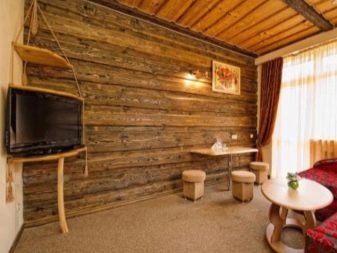

In the video below, you will learn how to sheathe a house with metal block house siding.













The comment was sent successfully.